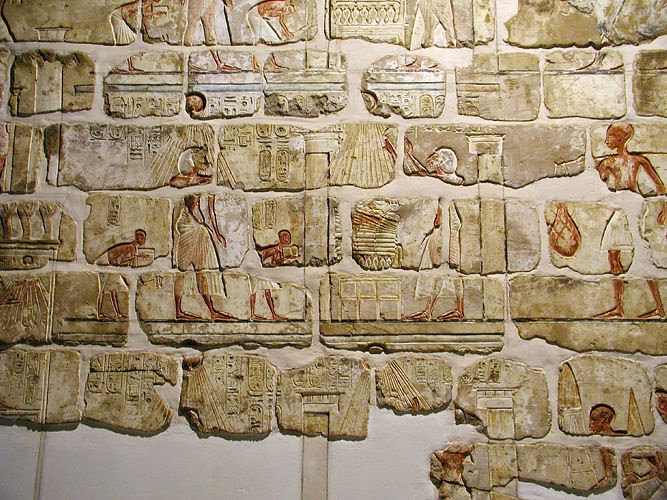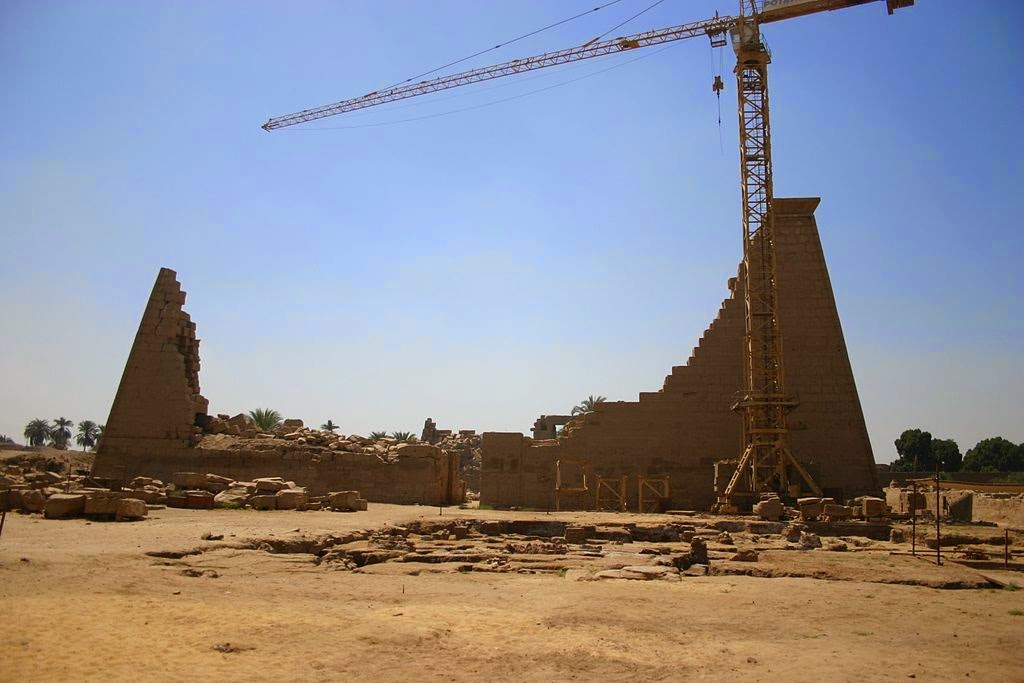Egypt

Recently I found myself viewing this image of the talatat wall of the Gempaaten created by the heretic King Amenhotep IV and erected at Karnak in the first years of his reign. The wall is in the much overlooked Luxor Museum of Egyptian Art and contains mostly rows of bowing people and workers bringing the produce of the lands to the king though Amenhotep IV is oblivious and preoccupied worshiping the Aten. The question that came to my mind was why the king was represented smaller than the servant to his right on the other side of the divide?
The servant being one in a row which increase in size as they approach the king. While the king on the left is surrounded by two bowing officials shown the correct size in relation to King Amenhotep, however here Amenhotep IV is no longer in an act of praise and he holds no offerings but stands frozen gazing in the direction of the approaching giant. The bowing officials may as well be bowing to the king on the right behind the divider as they may be observing themselves the approaching giant?
Perhaps the scenes are to be viewed as separate entities, though the effect is the same. First I would consider why the king built with much smaller blocks than his predecessors? Does this monument mock Amenhotep IV? Does the monument represent the power of the priests of Amen over the architects, stone masons and the king? That as a foresight thought to build a monument which would be much easier to dismantle after the death of the king,. Is the king being forced to use smaller blocks by the power of the high priest of Amen?

There is no question of authenticity to the wall as the blocks were used as fill in the ninth pylon created by King Horemheb, the last king of the Eighteenth Dynasty. Is the message that the King was lower than the lowest worker? The Luxor Museums 1978 guide book states that the king is always shown larger than everyone else. Yet here there is a giant servant approaching the king from behind.
The author Anneke Bart has a list of high priests and believes the high priest of Amen during the later reign of Amenhotep III and the early reign of Amenhotep IV was Maya, also known as Ptahmose. I cannot help but wonder of the relationship King Amenhotep and Maya had. It may well have been one of despise towards each other with Maya in control of the kings memory at Karnak and in the Theban zone.
The High Priest of Amen Maya may have initiated the policy of using talatat blocks for this monument which was continued throughout the kings reign. Still we are left with which wall the image was on, a wall seen by the king or the one at the back where the king was unlikely to see it too closely? One also has to wonder how much time Amenhotep IV wanted to spend at Karnak to notice such detail?
There is probably no answer remaining just thoughts.
Notes:
1) Ancient Egypt
- Yet Another Colossal Statue Of Amenhotep Iii
Here we find an image of a rather unimpressive looking monument of Amenhotep III, I suspect it was not reused for a reason, though confusingly the article refers to Amenhotep III as Tutankhamun's great grandfather. This statement is questionable as...
- Revisiting The Unearthing Egypt's Greatest Temple
This is a re-review of an older story from 2007. The mortuary temple of the 18th dynasty king Amenhotep III must have been quite the most sumptuous ever created. This kings reign was an artistic high, sadly little more than a century later an...
- Overlapping Kings
I noticed recently that when I aligned the third Amenhotep's year reign of 25 with his successor and namesakes year 1 that a number of curious dates begin to suggest that much of the fourth Amenhotep's reign may actually have run parallel to his...
- Overlapping Kings
It has been noticed that when aligned the third Amenhotep's year reign of 25 with his successor and namesakes year 1 that a number of curious dates begin to suggest that much of the fourth Amenhotep's reign may actually have run parallel to his...
- Overlapping Kings Of Amarna
I noticed recently that when I aligned the third Amenhotep's year reign of 25 with his successor and namesakes year 1 that a number of curious dates begin to suggest that much of the fourth Amenhotep's reign may actually have run parallel to his...
Egypt
The Talatat Wall in the Luxor Museum

Recently I found myself viewing this image of the talatat wall of the Gempaaten created by the heretic King Amenhotep IV and erected at Karnak in the first years of his reign. The wall is in the much overlooked Luxor Museum of Egyptian Art and contains mostly rows of bowing people and workers bringing the produce of the lands to the king though Amenhotep IV is oblivious and preoccupied worshiping the Aten. The question that came to my mind was why the king was represented smaller than the servant to his right on the other side of the divide?
The servant being one in a row which increase in size as they approach the king. While the king on the left is surrounded by two bowing officials shown the correct size in relation to King Amenhotep, however here Amenhotep IV is no longer in an act of praise and he holds no offerings but stands frozen gazing in the direction of the approaching giant. The bowing officials may as well be bowing to the king on the right behind the divider as they may be observing themselves the approaching giant?
Perhaps the scenes are to be viewed as separate entities, though the effect is the same. First I would consider why the king built with much smaller blocks than his predecessors? Does this monument mock Amenhotep IV? Does the monument represent the power of the priests of Amen over the architects, stone masons and the king? That as a foresight thought to build a monument which would be much easier to dismantle after the death of the king,. Is the king being forced to use smaller blocks by the power of the high priest of Amen?

There is no question of authenticity to the wall as the blocks were used as fill in the ninth pylon created by King Horemheb, the last king of the Eighteenth Dynasty. Is the message that the King was lower than the lowest worker? The Luxor Museums 1978 guide book states that the king is always shown larger than everyone else. Yet here there is a giant servant approaching the king from behind.
The author Anneke Bart has a list of high priests and believes the high priest of Amen during the later reign of Amenhotep III and the early reign of Amenhotep IV was Maya, also known as Ptahmose. I cannot help but wonder of the relationship King Amenhotep and Maya had. It may well have been one of despise towards each other with Maya in control of the kings memory at Karnak and in the Theban zone.
The High Priest of Amen Maya may have initiated the policy of using talatat blocks for this monument which was continued throughout the kings reign. Still we are left with which wall the image was on, a wall seen by the king or the one at the back where the king was unlikely to see it too closely? One also has to wonder how much time Amenhotep IV wanted to spend at Karnak to notice such detail?
There is probably no answer remaining just thoughts.
Notes:
1) Ancient Egypt
- Yet Another Colossal Statue Of Amenhotep Iii
Here we find an image of a rather unimpressive looking monument of Amenhotep III, I suspect it was not reused for a reason, though confusingly the article refers to Amenhotep III as Tutankhamun's great grandfather. This statement is questionable as...
- Revisiting The Unearthing Egypt's Greatest Temple
This is a re-review of an older story from 2007. The mortuary temple of the 18th dynasty king Amenhotep III must have been quite the most sumptuous ever created. This kings reign was an artistic high, sadly little more than a century later an...
- Overlapping Kings
I noticed recently that when I aligned the third Amenhotep's year reign of 25 with his successor and namesakes year 1 that a number of curious dates begin to suggest that much of the fourth Amenhotep's reign may actually have run parallel to his...
- Overlapping Kings
It has been noticed that when aligned the third Amenhotep's year reign of 25 with his successor and namesakes year 1 that a number of curious dates begin to suggest that much of the fourth Amenhotep's reign may actually have run parallel to his...
- Overlapping Kings Of Amarna
I noticed recently that when I aligned the third Amenhotep's year reign of 25 with his successor and namesakes year 1 that a number of curious dates begin to suggest that much of the fourth Amenhotep's reign may actually have run parallel to his...
